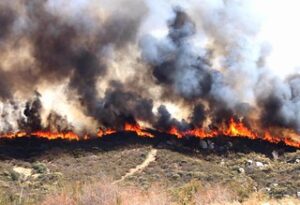Sonoma County Supervisor Lynda Hopkins spent a couple of hours Tuesday out on the fire lines with Sonoma County Fire Chief Mark Heine and posted this report on Facebook about how one of the wildfires is spreading. For those of us not from California, it provides a neutral explanation that helps us understand what’s going on. Here’s her report:
This fire is not functioning as a wind-driven wall of fire. Instead, it often takes the form of small fingers of fire “backing” its way downslope towards a valley floor. The good news is that this kind of fire behavior affords us an opportunity to defend structures, and even to defensively “guide” the flames towards roads and other fire breaks. The bad news is that these small fingers can burn gradually down to the floor of a valley, hit bottom, and then run back up to a ridgeline — gaining heat and speed as it heads upwards — making a sort of zig-zag pattern in the same canyon for days, even weeks.
It’s also worth remembering that low-intensity fires are generally a good thing for our fire-adapted ecosystems. They clear grass and brush from the forest floor, reducing fuel for a future fire. But the same area *could* actually burn twice. If the wind were to pick up, the fire could get into the canopy. (And the second time around, the canopy would be extremely dry, having been ‘baked’ from the ground-fire below.)
While county roads and dozer lines are currently functioning as fire breaks, even *without* wind causing spot fires, all it takes is one rolling smoldering log, or one falling fiery tree, to catch the other side of the road on fire. And given the steepness of the terrain, it doesn’t take much in the way of ladder fuels to facilitate fire running up a tree and catching the canopy on fire. (Think of it this way: a shrub on a very steep hillside might burst into flames, and because the hillside is so steep, that shrub is adjacent to the leafy mid-section of a tree that’s rooted further down the slope.) If those burning trees fall across a road, or a burning log rolls across a road, and there’s no firefighter present to catch it early, it can cause the fire to cross the fire break.
Good news: fire crews have been hard at work preparing properties and laying hose lines in areas of active fire. Also good news: crews are on hand to monitor the hotspots, so that a log or tree doesn’t roll across a fire break and cause the fire to leapfrog.
One of the most beautiful things I witnessed today were the firefighters attending the active fire in Armstrong Woods. The fire is there in the heart of the valley floor, burning in places I’ve walked dozens of times with my children through rain, frigid fog, or filtered sunshine. And what I saw was this: Firefighters treating our old growth redwood trees like the great beings that they are. Firefighters clearing away the bracken and brush at the bases of their mammoth trunks, protecting these 1,000+ year old giants, armed with hoses in case the fire made a run at our trees.
At the moment, the goal is not to extinguish the fire; the goal is to guide it. And in Armstrong, the goal is to keep it along the ground, out of the canopy.

